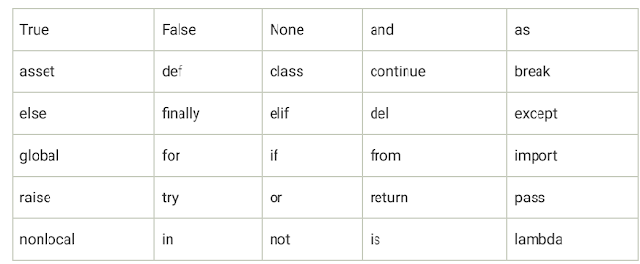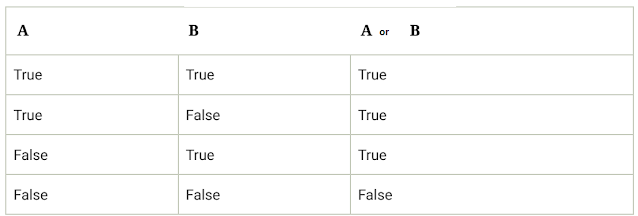Keywords of Python
Just like other programming languages, Python has a list of
reserved words known as keywords. Every keyword has a specific purpose and use.
It conveys a special meaning to the compiler/interpreter. Keywords of Python
are case-sensitive. These keywords can’t use variables in python. The list of
the keywords in Python:

Consider the following explanation of keywords:
- True - It represents the Boolean true, if the given condition is true, then it returns "True". Non-zero values are treated as true.
- False - It represents the Boolean false; if the given condition is false, then it returns "False". Zero value is treated as false
- None - It denotes the null value or void. An empty list or Zero can't be treated as None.
- and - It is a logical operator. It is used to check the multiple conditions. It returns true if both conditions are true. Consider the following truth table.

5. or -
It is a logical operator in Python. It returns true if one of the conditions is
true. Consider the following truth table.

6.
not -
It is a logical operator and inverts the truth value. Consider the following
truth table.

7.
assert - This
keyword is used as the debugging tool in Python. It checks the correctness of
the code. It raises an AssertionError if found any error in
the code and also prints the message with an error.
Example:
- a = 10
- b = 0
- print('a is dividing by Zero')
- assert b != 0
- print(a / b)
Output:
a
is dividing by Zero
Runtime
Exception:
Traceback
(most recent call last):
File
"/home/40545678b342ce3b70beb1224bed345f.py", line 4, in
assert b != 0, "Divide by 0
error"
AssertionError:
Divide by 0 error
8.
def - This
keyword is used to declare the function in Python. If followed by the function
name.
- def my_func(a,b):
- c = a+b
- print(c)
- my_func(10,20)
Output:
30
9.
class - It
is used to represents the class in Python. The class is the blueprint of the
objects. It is the collection of the variable and methods. Consider the
following class.
- class Myclass:
- #Variables……..
- def function_name(self):
- #statements………
10.
continue - It is used to stop the execution of the current iteration.
Consider the following example.
- a = 0
- while a < 4:
- a += 1
- if a == 2:
- continue
- print(a)
Output:
1
3
4
11.
break - It
is used to terminate the loop execution and control transfer to the end of the
loop. Consider the following example.
Example
- for i in range(5):
- if(i==3):
- break
- print(i)
- print("End of execution")
Output:
0
1
2
End
of execution
12. If - It is used to represent the conditional statement. The execution of a particular block is decided by if statement. Consider the following example.
Example
- i = 18
- if (1 < 12):
- print("I am less than 18")
Output:
I
am less than 18
13.
else - The
else statement is used with the if statement. When if statement returns false,
then else block is executed. Consider the following example.
Example:
- n = 11
- if(n%2 == 0):
- print("Even")
- else:
- print("odd")
Output:
Odd
14.
elif - This
Keyword is used to check the multiple conditions. It is short for else-if.
If the previous condition is false, then check until the true condition is
found. Condition the following example.
Example:
- marks = int(input("Enter the marks:"))
- if(marks>=90):
- print("Excellent")
- elif(marks<90 and marks>=75):
- print("Very Good")
- elif(marks<75 and marks>=60):
- print("Good")
- else:
- print("Average")
Output:
Enter
the marks:85
Very
Good
15.
del - It
is used to delete the reference of the object. Consider the following example.
Example:
- a=10
- b=12
- del a
- print(b)
- # a is no longer exist
- print(a)
Output:
12
NameError:
name 'a' is not defined
16.
try, except - The try-except is used to handle the exceptions. The
exceptions are run-time errors. Consider the following example.
Example:
- a = 0
- try:
- b = 1/a
- except Exception as e:
- print(e)
Output:
division
by zero
17.
raise - The
raise keyword is used to through the exception forcefully. Consider the
following example.
Example
- a = 5
- if (a>2):
- raise Exception('a should not exceed 2 ')
Output:
Exception:
a should not exceed 2
18.
finally - The finally keyword
is used to create a block of code that will always be executed no matter the
else block raises an error or not. Consider the following example.
Example:
- a=0
- b=5
- try:
- c = b/a
- print(c)
- except Exception as e:
- print(e)
- finally:
- print('Finally always executed')
Output:
division
by zero
Finally
always executed
19.
for, while - Both keywords are used for iteration. The for keyword
is used to iterate over the sequences (list, tuple, dictionary, string). A
while loop is executed until the condition returns false. Consider the following
example.
Example:
For loop
- list = [1,2,3,4,5]
- for i in list:
- print(i)
Output:
1
2
3
4
5
Example:
While loop
- a = 0
- while(a<5):
- print(a)
- a = a+1
Output:
0
1
2
3
4
20.
import - The
import keyword is used to import modules in the current Python script. The
module contains a runnable Python code.
Example:
- import math
- print(math.sqrt(25))
Output:
5
21.
from - This
keyword is used to import the specific function or attributes in the current
Python script.
Example:
- from math import sqrt
- print(sqrt(25))
Output:
5
22.
as - It
is used to create a name alias. It provides the user-define name while
importing a module.
Example:
- import calendar as cal
- print(cal.month_name[5])
Output:
May
23.
pass - The pass keyword
is used to execute nothing or create a placeholder for future code. If we
declare an empty class or function, it will through an error, so we use the
pass keyword to declare an empty class or function.
Example:
- class my_class:
- pass
- def my_func():
- pass
24.
return - The return keyword
is used to return the result value or none to called function.
Example:
- def sum(a,b):
- c = a+b
- return c
- print("The sum is:",sum(25,15))
Output:
The
sum is: 40
25.
is - This
keyword is used to check if the two-variable refers to the same object. It
returns the true if they refer to the same object otherwise false. Consider the
following example.
Example
- x = 5
- y = 5
- a = []
- b = []
- print(x is y)
- print(a is b)
Output:
True
False
Note: A mutable data-types do not refer to the same object.
26.
global - The
global keyword is used to create a global variable inside the function. Any
function can access the global. Consider the following example.
Example
- def my_func():
- global a
- a = 10
- b = 20
- c = a+b
- print(c)
- my_func()
- def func():
- print(a)
- func()
Output:
30
10
27.
nonlocal - The nonlocal is similar to the global and
used to work with a variable inside the nested function(function inside a
function). Consider the following example.
Example
- def outside_function():
- a = 20
- def inside_function():
- nonlocal a
- a = 30
- print("Inner function: ",a)
- inside_function()
- print("Outer function: ",a)
- outside_function()
Output:
Inner
function: 30
Outer
function: 30
28.
lambda - The
lambda keyword is used to create the anonymous function in Python. It is an
inline function without a name. Consider the following example.
Example
- a = lambda x: x**2
- for i in range(1,6):
- print(a(i))
Output:
1
4
9
16
25
29.
yield - The yield keyword
is used with the Python generator. It stops the function's execution and
returns value to the caller. Consider the following example.
Example
- def fun_Generator():
- yield 1
- yield 2
- yield 3
# Driver code to check above generator function
- for value in fun_Generator():
- print(value)
Output:
1
2
3
30.
with - The with keyword
is used in the exception handling. It makes code cleaner and more readable. The
advantage of using with, we don't need to call close().
Consider the following example.
Example
with open('file_path', 'w') as file:
file.write('hello world !')
31.
None – The
None keyword is used to define the null value. It is remembered that None does
not indicate 0, false, or any empty data-types. It is an object of its data
type, which is Consider the following example.
Example:
- def return_none():
- a = 10
- b = 20
- c = a + b
- x = return_none()
- print(x)
Output:
None
We
have covered all Python keywords. This is the brief introduction of Python
Keywords. We will learn more in the upcoming tutorials.
